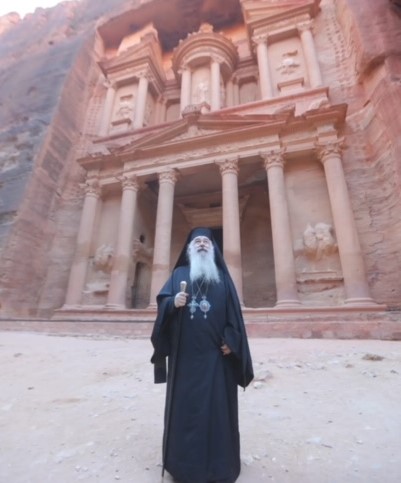

The ancient city of Petra witnessed the first mass in the
ancient Byzantine church during the month of January of this year.
The church complex discovered in 1990 is a large, clear
cathedral that indicates the civilization of the place at that time and
confirms the presence of Christianity in Petra in the early stages.
The discoverer of this church was the Italian archaeologist
Franco Ciorelli with his team excavating the Rosary City. Its construction
dates back to the year 450 AD and was built on the ruins of Roman Nabataean
ruins. There is a cohesive mosaic piece measuring 70 square meters in length on
both ends of the structure, representing the four seasons and depicting the
oceans.
Petra witnessed the first Divine Mass on Monday, January 22,
2024, when His Eminence Bishop Christoforos, the Greek Orthodox Bishop of
Jordan, presided over the Divine Mass service in the ancient Roman Church of
Petra for the first time after 1,500 years of the Roman-Byzantine era.
It was noteworthy that the venerable priest fathers
participated and the presence of the nuns of the sisterhood of the Monastery of
the Virgin Mary, Fountain of Life - Dibbin, and the committees of church ladies
from various governorates of the Kingdom, and a number of public and diplomatic
figures also attended.
During his speech, the Bishop reviewed the Roman-Byzantine
history in the Petra region, and how Christianity flourished in the
Metropolitan City of Petra, where it was a center with seven bishops. He also
referred to the monastic life that was widespread in Petra and its environs.
The church bears the name of the Blessed Lady and the Most
Glorious Most Holy Virgin Mary. Two other churches were also uncovered, namely
the Blue Church and the Ridge Church on the hillside. Petra Cathedral is
located a few hundred meters from the Column Street and the Temple of the
Winged Lions, and it constitutes an interesting archaeological site. It is
expected to be a site of Christian pilgrimage.
According to historical information, the church was built in
450 AD. It contains in its center columns, distinctive mosaic floors,
inscriptions in the Greek language, and an apse for the structure. It is
considered one of the largest churches in the city of Petra. As for the outer
part of it, “the catechumens,” it contains a large baptismal font and a water
well surrounded by antique Roman columns.
According to the papyrus scroll manuscripts found in a cave
adjacent to the church dating back to the sixth century AD, it was mentioned
that the church was dedicated to the Virgin Mary, the Mother of God. It also
explains that the church was built in the form of a basilica with two
semi-circular side apses.
The visitor arrives at the complex of ancient churches
through the visitor center, then heads towards the Siq and the Treasury, then
begins walking towards the temple, which takes ten minutes and reaches the
church.